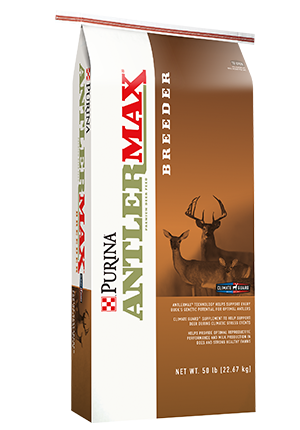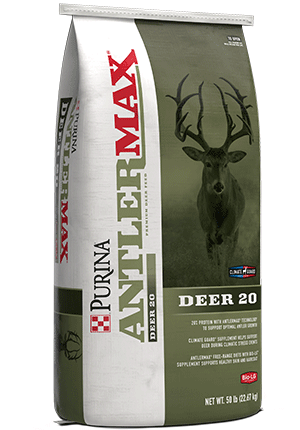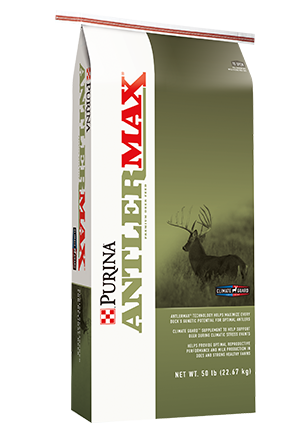
Balancing Deer Nutrition
Deer : Nutrition

Nutrition is the foundation for maintaining healthy productive deer and elk populations.
It is important to provide a well-balanced wildlife feed that provides all the nutrient classes in proper amounts to meet your animal's needs.
Deer, like all ruminant animals, eat to meet their energy needs. The need for energy drives daily intake. It’s this need, and the appeal of palatability that influences what a deer eats. Deer may need to eat more of a low-energy feed in order to meet their demand for calories. Likewise, deer may need to eat less of a higher-quality, higher-energy feed. Since deer eat to meet an energy requirement, the other nutrients (fiber, protein, vitamins and minerals) must be in proportion with the energy amount, so that the deer gets what it needs of all nutrients in the amount of feed that it will eat. For instance, a high-energy low-protein feed will not provide enough protein because the deer will eat only until its energy requirement is met. A high-energy, low-fiber feed (such as corn) can actually get your deer in trouble if they eat too much at once.
Deer also like to eat what is palatable. Given a choice, they will eat the more palatable feed, even if the less palatable feed contains more of the nutrients they need. Corn is a perfect example of a highly palatable but nutritionally deficient feed that deer will eat before eating almost anything else, even to their own detriment.
When choosing a feed, it’s important to review the feeding rate. While a certain feed may have a higher price per bag, it may cost less per year because deer will need to eat less. On the other hand, a feed that has been cheapened up by increasing the fiber and ash content will have an appealing price tag but may end up costing more in the long run because you will have to feed more of it. Feeding deer large amounts of something inexpensive and palatable like corn will also cost in lost productivity and antler growth. Making sure deer get the balanced nutrition they need year-round can result in optimal antler growth and health, maximizing production and profitability.
It is important to provide a well-balanced wildlife feed that provides all the nutrient classes in proper amounts to meet your animal's needs.
Deer, like all ruminant animals, eat to meet their energy needs. The need for energy drives daily intake. It’s this need, and the appeal of palatability that influences what a deer eats. Deer may need to eat more of a low-energy feed in order to meet their demand for calories. Likewise, deer may need to eat less of a higher-quality, higher-energy feed. Since deer eat to meet an energy requirement, the other nutrients (fiber, protein, vitamins and minerals) must be in proportion with the energy amount, so that the deer gets what it needs of all nutrients in the amount of feed that it will eat. For instance, a high-energy low-protein feed will not provide enough protein because the deer will eat only until its energy requirement is met. A high-energy, low-fiber feed (such as corn) can actually get your deer in trouble if they eat too much at once.
Deer also like to eat what is palatable. Given a choice, they will eat the more palatable feed, even if the less palatable feed contains more of the nutrients they need. Corn is a perfect example of a highly palatable but nutritionally deficient feed that deer will eat before eating almost anything else, even to their own detriment.
When choosing a feed, it’s important to review the feeding rate. While a certain feed may have a higher price per bag, it may cost less per year because deer will need to eat less. On the other hand, a feed that has been cheapened up by increasing the fiber and ash content will have an appealing price tag but may end up costing more in the long run because you will have to feed more of it. Feeding deer large amounts of something inexpensive and palatable like corn will also cost in lost productivity and antler growth. Making sure deer get the balanced nutrition they need year-round can result in optimal antler growth and health, maximizing production and profitability.



